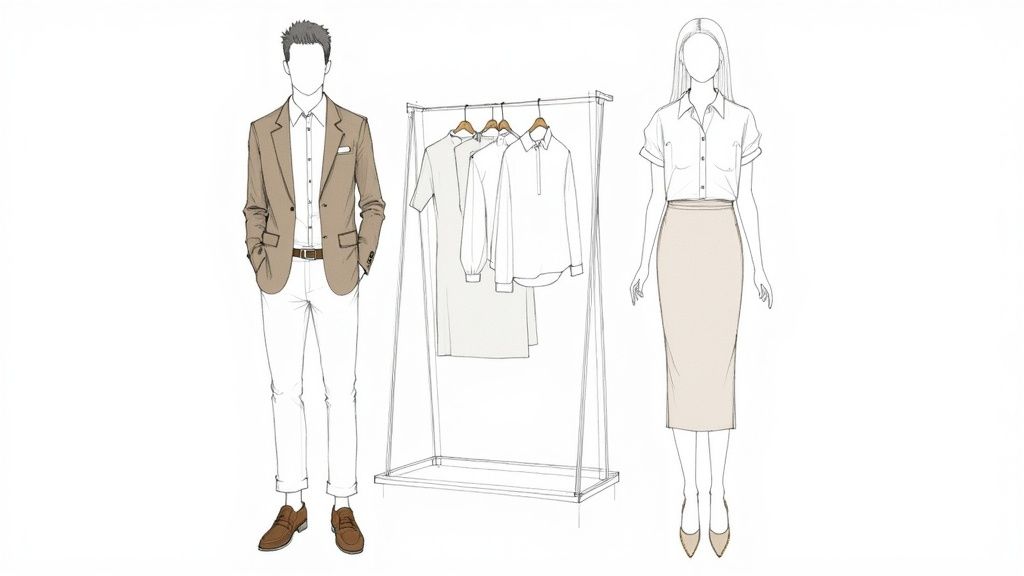
Master the Business Casual Dress Code
By Emma Johnson - 9/24/2025
Ever found yourself staring into your closet, completely stumped by the phrase "business casual"? You're definitely not alone. It's one of those dress codes that feels intentionally vague.
At its core, business casual is all about striking a balance. It's the art of looking put-together and professional without having to wear a full, formal suit. Think of it as blending everyday comfort with workplace competence.
What Is the Modern Business Casual Dress Code?
Let's be honest, the term "business casual" feels like a contradiction. How can something be both at once? The trick is to find that perfect middle ground—an outfit that says you're serious about your work but in a more relaxed, approachable way.
Imagine a clothing spectrum. On one end, you have the classic suit and tie. On the other, your weekend uniform of t-shirts and jeans. Business casual sits right in the sweet spot between them.
This style has changed a lot over the years, especially with the rise of flexible work. The goal is to project a professional image that shows respect for your environment, but with enough room for personal style and comfort. It's less about a strict uniform and more about building a smart, versatile wardrobe.
A Shift Toward Comfort and Style
The pandemic really sped up the move away from stuffy office attire. What we consider "work-appropriate" has fundamentally changed. In fact, one report showed that only 4.3% of companies still require a formal dress code. If you're curious, you can read more about this workplace shift on Raconteur.net. This massive shift has pretty much cemented business casual as the new normal for countless industries.
When in doubt, always lean a little more "business" than "casual." It’s always better to be slightly overdressed than to look like you didn't put in the effort. Your clothing is a silent reflection of your professional judgment.
Once you get the hang of this balance, picking out an outfit becomes second nature. You'll be able to walk into any professional setting feeling confident and looking the part.
From Stuffy Suits to Smart Chinos
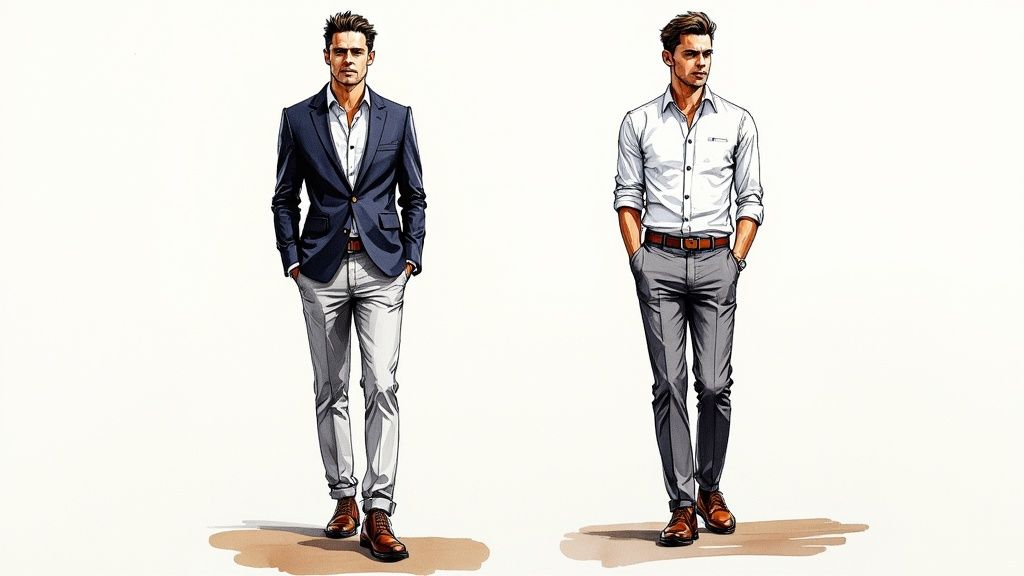
To really get a handle on modern business casual, it helps to know its story. Think back just a few decades, and the professional world was a uniform sea of dark suits, starched white shirts, and mirror-shined dress shoes. That was it. This was the non-negotiable uniform for anyone serious about climbing the corporate ladder.
Things started to loosen up in the second half of the 20th century. One of the first little nudges toward a more relaxed vibe was "Aloha Friday" in Hawaii. The idea of wearing a Hawaiian shirt to work, even just once a week, was a small but significant crack in the armor of corporate formality. It planted the seed.
The Silicon Valley Effect
But the real earthquake came from the tech boom. As startups in Silicon Valley began to disrupt entire industries, they threw the old dress code rulebook out the window right along with them. Icons like Steve Jobs and Bill Gates famously ditched the corporate uniform for something far more comfortable and personal.
Their philosophy was straightforward: great ideas and creativity don't come from a suit and tie. That mindset caught on, fast. A new professional ideal emerged, one that valued comfort and individual expression. All of a sudden, chinos, polo shirts, and loafers weren't just acceptable; they were the new uniform of innovation. This was the moment that truly cemented the foundation of what we think of as business casual today.
A Return to Structure
Interestingly, the journey wasn't a straight line from suits to hoodies. After the initial casual wave, some offices got a little too relaxed, prompting many companies to pull back and find a happy medium. Formal casual policies actually dropped from 53% in 2002 to 38% in the years that followed as businesses searched for a balance. You can explore more insights on workplace dress code shifts to get the full picture of this evolution.
This history explains why "business casual" can feel so ambiguous—it was born from a tug-of-war between formal tradition and casual innovation.
Understanding this backstory is crucial. It reminds us that business casual isn't just a random list of dos and don'ts; it’s a direct reflection of how our ideas about work have changed. Of course, knowing the history is one thing; you still have to build the wardrobe. A great place to start is with the right palette—you can discover the best neutral colors for your skin tone in our guide. This context gives you the power to confidently interpret the dress code for whatever office you walk into.
Your Guide to Men's Business Casual
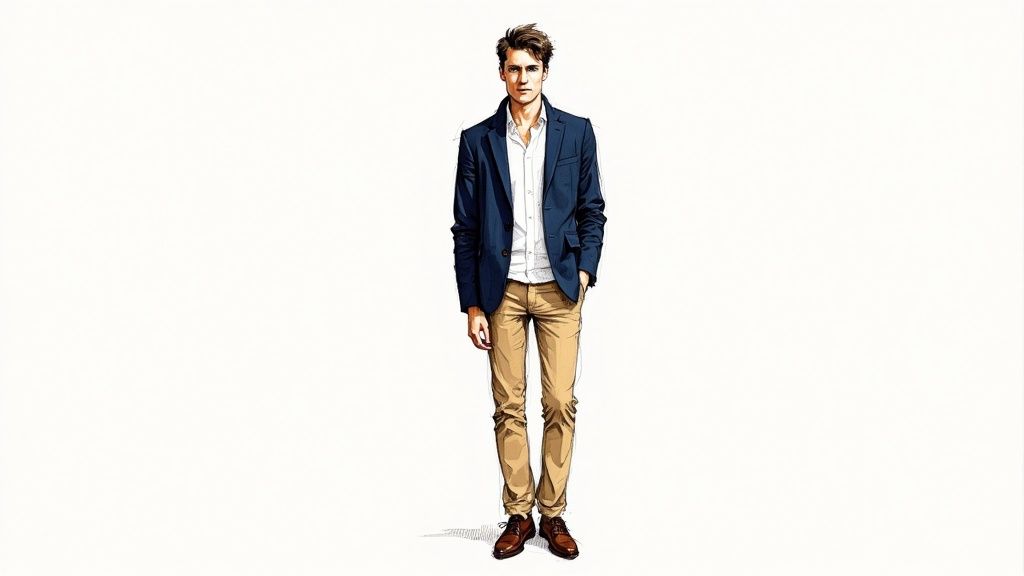 Let's be honest: navigating the "business casual" dress code can feel like you're trying to hit a moving target. It’s tricky. Instead of just giving you vague advice, we're going to build a clear, foundational wardrobe system.
Let's be honest: navigating the "business casual" dress code can feel like you're trying to hit a moving target. It’s tricky. Instead of just giving you vague advice, we're going to build a clear, foundational wardrobe system.
Think of it less like a rigid uniform and more like a collection of interchangeable parts. The goal is to own a handful of high-quality staples that you can mix and match endlessly. This not only saves you time in the morning but also ensures you always look sharp and put-together.
The Foundational Pieces
The absolute bedrock of any man's business casual wardrobe is the collared shirt. Start by collecting a few crisp button-downs in versatile, neutral colors—think classic white, light blue, and a solid grey. For days when the office vibe is a bit more relaxed, a high-quality polo shirt in a dark, solid color is a perfect substitute.
Now for the bottom half. You really only need to master two core options:
- Chinos: These are essential, period. Get a few well-fitting pairs in staple colors like khaki, navy, and grey. Fit is everything here—nothing too baggy, nothing too skinny.
- Dark-Wash Denim: In most modern workplaces, a great pair of dark jeans is totally acceptable. The key is to make sure they are a solid, dark wash with no rips, distressing, or heavy fading. If you're ever unsure, just take a look at what senior leadership is wearing.
This simple formula—a collared shirt paired with either chinos or smart denim—is the backbone of virtually every business casual outfit you'll ever need.
Smart Layering and Footwear
This is where you take a basic outfit and make it look intentional. A well-cut blazer or sport coat in navy or charcoal is the ultimate power move; it instantly elevates anything you're wearing. For a slightly more relaxed but still polished feel, a fitted merino wool sweater or a classic cardigan works wonders.
Your footwear grounds your entire look, and frankly, it's where a lot of guys drop the ball. Your shoes must be clean, professional, and well-kept. Athletic sneakers and beat-up running shoes are an absolute no-go.
This is the final detail that ties your whole professional image together. To complete your ensemble, finding the right footwear is crucial; learn more about the style and comfort of these Top Black Business Casual Shoes for Men. Great options include loafers, derby shoes, or even chukka boots. Clean, minimalist leather sneakers in a dark color can also work perfectly, bridging that gap between formal and casual.
Your Guide to Women's Business Casual
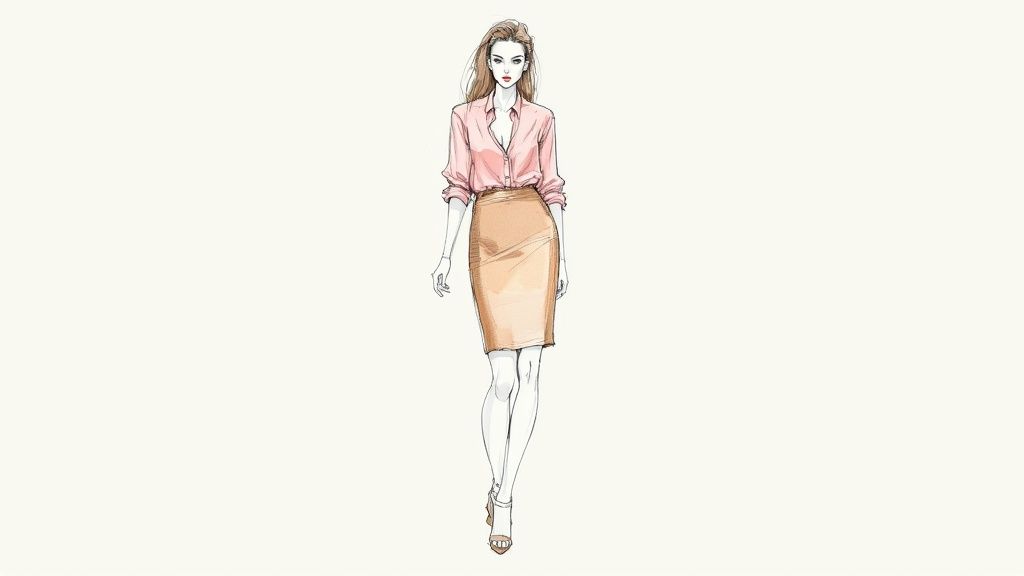
When it comes to women's business casual, think less about a rigid set of rules and more about building a collection of versatile, high-quality pieces. The real goal is to create a wardrobe that makes you feel as confident and polished as you look, allowing your personal style to shine through while always maintaining a professional edge.
Think of it as creating a core group of items that you can mix and match without a second thought. This not only makes your mornings easier but ensures you always have a sharp, go-to outfit ready for any day at the office. It all begins with a solid foundation.
Building Your Foundational Wardrobe
The heart of your business casual wardrobe will always be well-fitting, comfortable, and professional tops and bottoms. These are the workhorses that will form the basis for dozens of different looks.
Let’s start with tops. An elegant blouse in a solid color or a subtle pattern is non-negotiable. Quality knit tops and fine-gauge sweaters also strike that perfect balance between comfort and polish. Just be mindful of necklines—it's best to steer clear of anything too low-cut to keep your look professional.
As for bottoms, you can't go wrong with classic silhouettes:
- Tailored Trousers: Invest in a few great pairs in neutral colors like black, navy, or charcoal. Whether you prefer a straight-leg or a wide-leg cut, the fit is what matters most.
- Skirts and Dresses: A classic pencil skirt, a flattering A-line skirt, or a structured sheath dress are all fantastic options. For a universally professional look, make sure hemlines fall at or just below the knee.
A great rule of thumb for building a versatile closet is the 3:1 ratio. Aim for three tops for every one bottom. People are far more likely to notice the shirt you're wearing, so having more variety on top lets you create fresh looks using the same core trousers or skirts.
The Art of Accessorizing
Once you have your foundational pieces sorted, accessories are where you can really inject your personality into your workwear. The right accessory can instantly elevate an outfit from standard to stylish, but the key here is subtlety.
Choose pieces that complement your look rather than overpower it. You can refine your office style by adding tasteful and stylish business casual jewelry for work. A simple watch, delicate earrings, or a classic handbag can be the perfect finishing touch to complete your ensemble.
Color also plays a huge part in tying everything together and making a strong impression. Knowing which shades flatter you most can be a total game-changer for your professional style. You can discover your best colors when you https://aicoloranalysis.com/blog/find-your-color-palette. By combining the right colors with classic pieces and thoughtful accessories, you’ll craft a business casual style that is uniquely and confidently you.
Common Missteps and How to Avoid Them
Figuring out what to wear is only half the battle. Knowing what not to wear is just as crucial. The business casual dress code is famous for its gray areas, making it surprisingly easy to step over the line from "relaxed professional" to just plain "unprofessional."
Think of your work outfit like a handshake—it's your first impression. Clothes that are obviously too casual, like frayed jeans, t-shirts with loud graphics, workout gear, or flip-flops, send a clear message. They scream "weekend" in a weekday environment, which can chip away at your professional credibility before you even open your mouth.
Keeping It Professional, Not Personal
The whole point of business casual is to look put-together without being stuffy. The most common mistakes happen when comfort completely steamrolls professionalism. For example, while a nice pair of dark-wash jeans might be perfectly fine in your office, a pair that's ripped, heavily faded, or distressed belongs strictly to your off-duty hours.
Likewise, a plain, high-quality t-shirt layered under a blazer can work in some creative industries, but a t-shirt with a band logo or a quirky slogan is almost always a miss.
The image below gives a great visual breakdown of some of the most frequent business casual blunders.
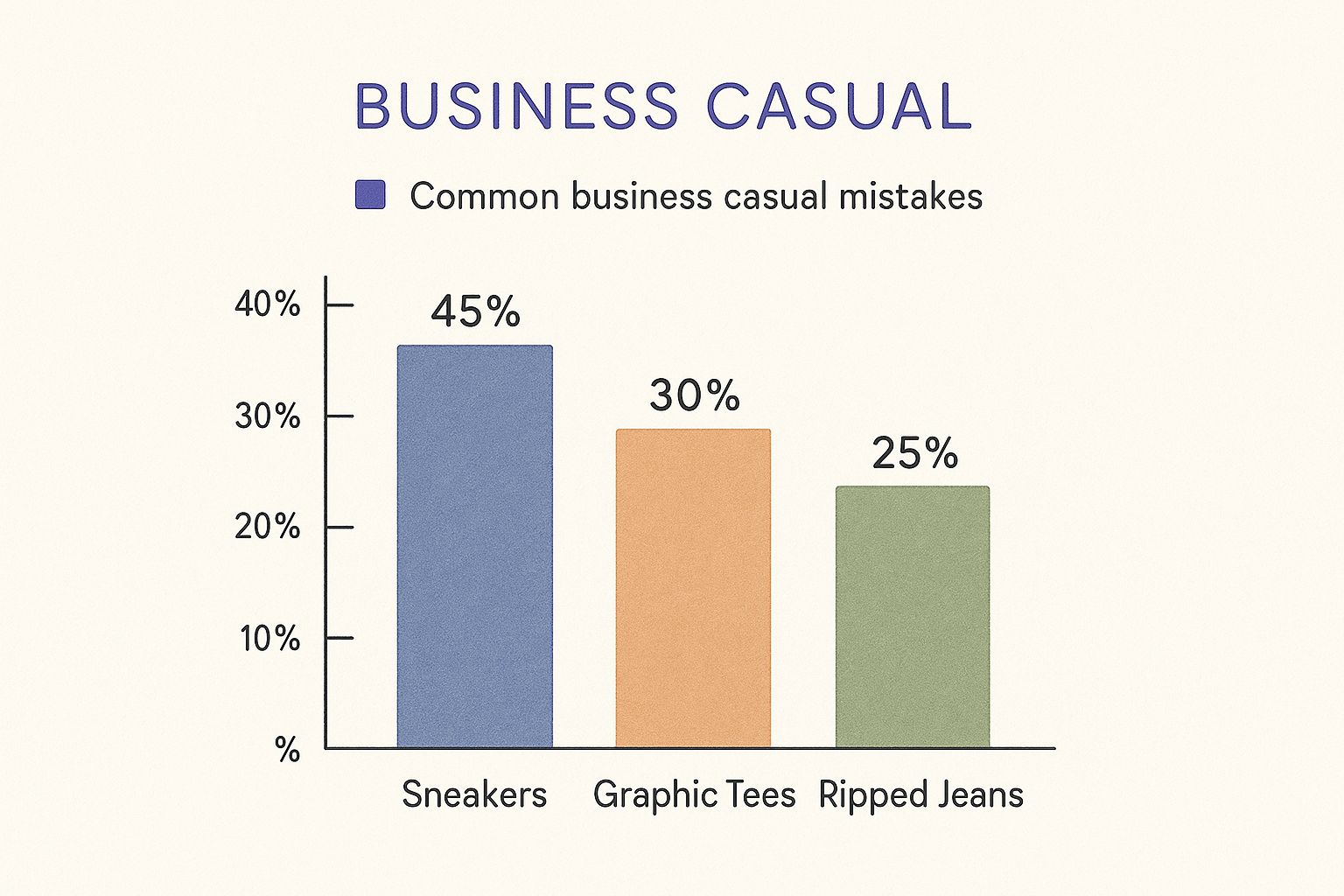
It’s pretty clear from this that footwear is a major stumbling block, with sneakers being the top offender. This just goes to show how one single overly casual item can drag down an otherwise great outfit.
When in doubt, ask yourself one simple question: "Would I wear this to relax on my couch, or would I wear it to meet an important client?" That little mental check is your best defense against most dress code mistakes.
To make things even clearer, let's break down the do's and don'ts side-by-side.
Business Casual Do's and Don'ts
This table offers a straightforward comparison to help you navigate your wardrobe choices.
| Clothing Category | Business Casual (Do) | Too Casual (Don't) |
|---|---|---|
| Pants | Chinos, dark-wash denim (no rips), tailored trousers | Ripped jeans, sweatpants, shorts, leggings |
| Tops | Collared shirts, blouses, quality knit sweaters, polo shirts | Graphic t-shirts, tank tops, hoodies, strapless tops |
| Outerwear | Blazers, sport coats, cardigans, structured jackets | Jean jackets, athletic hoodies, windbreakers |
| Footwear | Loafers, Oxfords, dress boots, flats, clean minimalist sneakers | Flip-flops, athletic running shoes, worn-out sneakers |
By keeping these guidelines in mind, you can navigate the nuances of business casual with confidence. The safest bet is always to err on the side of being slightly overdressed. It's a simple strategy, but it ensures you always look sharp, capable, and ready to take on the day.
Adapting Your Look for Any Professional Setting
https://www.youtube.com/embed/uJQdpmW7ayY
The term “business casual” isn’t a one-size-fits-all uniform. It’s more of a flexible concept that really shifts depending on where you work. Nailing this dress code is all about learning to read the room and tweaking your outfit to match the specific expectations of your industry, your company, and even what’s on your calendar for the day.
Think of it like adjusting the volume on a speaker. A normal day at the office? You're probably at a comfortable medium. But for a big client meeting, you'll want to dial it up with a sharp blazer or more formal trousers to project a bit more authority and confidence.
On the flip side, for a casual company outing or a team-building event, you can dial it back down with a great pair of dark-wash jeans or a more relaxed top. This ability to adapt is a sign of professional savvy—it shows you understand and respect the context you're in. The core idea stays the same, but how you pull it off changes with the situation.
Industry and Company Culture
What passes for business casual can be worlds apart from one industry to another. An outfit that’s perfectly normal in a creative ad agency might look way too relaxed in a buttoned-up financial firm.
- Conservative Fields (Finance, Law): Here, business casual leans heavily toward the "business" side of the equation. We're talking tailored trousers, structured blouses, blazers, and dress shoes. The goal is a polished, understated look that respects tradition.
- Creative Fields (Marketing, Tech): These workplaces usually give you more room for personal style. Things like dark-wash jeans, clean minimalist sneakers, and brighter colors are often totally fine.
A global poll once found that only about 34% of workers wore formal business attire, with huge differences from region to region. What’s really interesting is that 45% of people surveyed believed employees in casual clothes were actually more productive. You can discover more insights about workplace attire perceptions at Ipsos.com.
This really shows how much our work culture influences our clothing norms. The best way to get it right is to simply observe what’s going on in your own office. Pay attention to what senior leaders and respected colleagues are wearing—that’s usually your most reliable guide.
Knowing the colors that flatter you can also give you a professional edge. You can learn more about this by figuring out what your skin undertone is. Ultimately, adapting your look is a powerful way to show you get it—you understand and respect the professional world you're a part of.
Your Business Casual Questions Answered
Even when you think you've got the business casual dress code figured out, a specific meeting or a change in seasons can throw a wrench in your plans. Let's walk through some of the most common questions that pop up when you're staring into your closet before work.
Getting these details right is what separates looking just "okay" from looking truly put-together and professional. Here are some straightforward answers to help you nail it every time.
Are Jeans Actually Okay for a Business Casual Office?
This is probably the biggest gray area, and the answer really comes down to your specific workplace. In a lot of creative or tech offices, a pair of dark-wash, well-fitting jeans (with no rips, fraying, or fading!) is a weekday staple. But if you're in a more traditional field like finance or law, you're much safer sticking with classic chinos or dress pants.
Here's a pro tip: Take a look at what the senior managers and executives are wearing. Their daily choices are the best guide to the real dress code. If you're ever on the fence, it's always better to be a little overdressed than too casual.
What Are the Go-To Shoes for Business Casual?
You have plenty of great options that go far beyond standard dress shoes.
- For men, you can't go wrong with loafers, derbies, chukka boots, or classic oxfords. They all add a nice, polished finish to an outfit.
- For women, stylish flats, loafers, block heels, and sophisticated boots are all fantastic choices.
In some more relaxed offices, even a pair of clean, minimalist leather sneakers can look sharp on anyone. Just be sure to steer clear of your gym sneakers, flip-flops, or any overly casual sandals.
How Do I Pull Off Business Casual When It's Hot Outside?
Staying cool without looking like you're headed to the beach is all about the fabric. Look for lightweight, breathable materials like linen, cotton, and chambray. These will keep you comfortable while still looking sharp.
For men, a high-quality polo or a short-sleeved button-down shirt is a great option. For women, a professional sleeveless blouse or a pair of breezy linen trousers works perfectly. The key is to maintain a polished silhouette, even when you're dressing for the heat.
Take your style to the next level with a professional analysis
You already know the theory. Now discover exactly which colors and styles enhance your personal image.
Loading...
Complete PDF report in less than 5 minutes
Your color season and personalized palette
Specific makeup and clothing recommendations
Based on professional color analysis
One-time investment:
One-time payment, no subscriptions. Instant access.